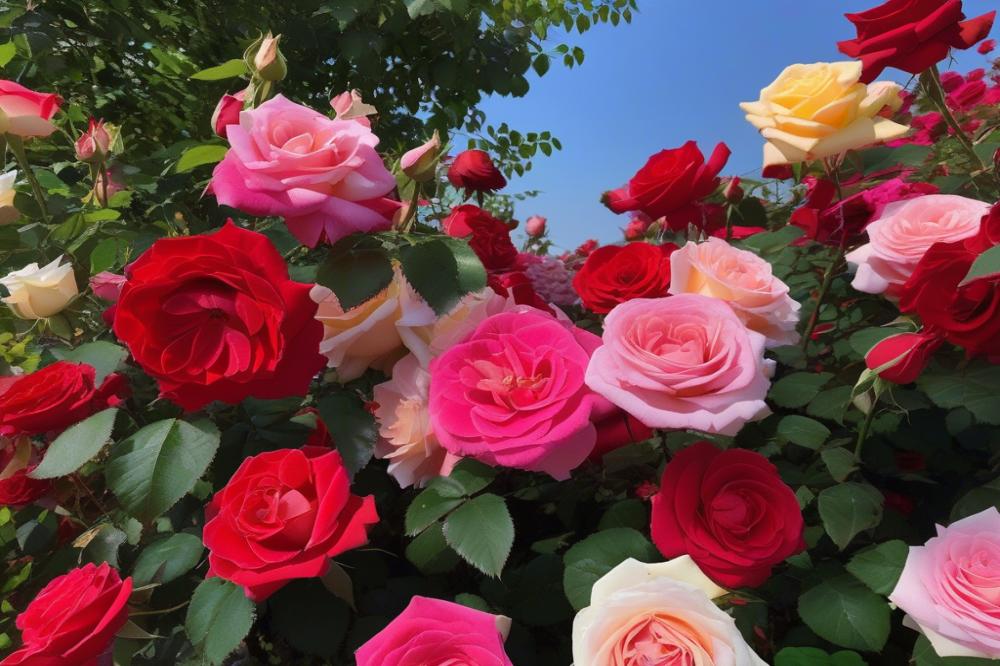How to Choose the Right Rose for Different Climates
Roses hold a special place in gardening. They are loved by many due to their beauty and fragrance. Enthusiasts appreciate these flowers for their variety and the joy they bring. However, it is crucial to recognize that roses thrive in different environments. Each region presents its own challenges and advantages for growing this popular flower.
Climate variations can deeply affect how plants grow. Factors such as temperature, humidity, and sunlight play significant roles. Some roses flourish in warm, sunny areas, while others prefer cooler climates. Understanding these climate factors is essential for gardeners aiming to cultivate healthy rose bushes.
Selecting the right rose for your particular climate can make all the difference. Choosing a rose unsuitable for your environment can lead to disappointment. A knowledgeable gardener must consider local conditions to achieve the best results. The right rose can bring beauty to your garden and thrive year after year. For more information on suitable varieties for varying climates, check #anchor_text_1# and discover how to bloom in adverse weather conditions. Ultimately, the careful selection of #anchor_text_2# can contribute to a flourishing, vibrant garden.
Understanding Roses and Climate

Overview of Different Rose Varieties
Roses come in various types. Some are specifically bred for hardiness, while others thrive in warmer conditions. Hybrid tea roses offer large blooms and growth adaptability. Floribunda roses are also popular and bloom abundantly. Climbing roses can decorate fences and trellises effectively. Shrub roses are often very resilient and need less care. Knowing these different types can help in choosing the best for your area.
Description of How Climate Affects Rose Growth
Climate plays a significant role in rose development. Regions with cold winters might favor hardy varieties that can withstand frost. In warmer areas, roses can experience issues like heat stress and dehydration. Humidity levels can also impact health. High moisture levels may lead to diseases like powdery mildew. Sun exposure is another critical factor; roses generally favor full sun for optimal growth. Too much shade can limit their blooming potential and overall vitality.
Importance of Local Climate Conditions in Rose Selection
Choosing the right rose involves understanding local climate specifics. For example, areas with frequent frost should focus on cold-hardy selections. In contrast, hotter climates may require varieties that tolerate high temperatures. Checking the USDA Plant Hardiness Zone Map can provide helpful insights into what grows best in your vicinity. Local gardeners’ experiences can offer valuable perspectives too. Observations about rainfall patterns, soil type, and overall temperature can guide your decision. Each of these factors together helps in selecting roses that will thrive in your unique setting.
Types of Climates and Compatible Roses

Climate types affect plant selection. Broadly, climates can be classified into four types: temperate, tropical, arid, and cold. Each type has its own variables such as temperature, humidity, and rainfall levels. Choosing the right roses involves understanding these factors.
Roses Suitable for Temperate Climates
Temperate climates typically exhibit four distinct seasons. This environment supports many varieties of roses. From hybrid teas to floribundas, selections are plentiful. Some popular options include the ‘Peace’ rose, known for its large blooms and strong fragrance, and ‘Gertrude Jekyll’, celebrated for its charming scent and compact growth. These roses thrive best when given ample sunlight and well-drained soil.
Roses That Thrive in Tropical Conditions
Tropical climates offer warmth and humidity. Here, certain types of roses flourish exceptionally well. For instance, the ‘Rosa chinensis’, or China rose, adapts beautifully. Its resilience makes it perfect for these regions. Additionally, ‘The Poets Wife’ rose thrives in warm weather, showcasing bright blooms. Regular care, including watering and pruning, can enhance growth in these lush environments.
Choosing Roses for Arid or Dry Climates
Dry climates present unique challenges. High temperatures and low rainfall can stress most plants. However, certain roses can adapt. Look for drought-resistant varieties like ‘Knock Out’, which is known for its hardiness. ‘Hansens’ rose also holds up well in dry areas, offering vibrant flowers. Limited watering strategies, paired with mulching, will help maintain soil moisture.
Considerations for Cold Climates and Frost Tolerance
Cold climates require careful planning. Frost tolerance becomes a crucial factor when choosing roses. Varieties such as ‘Honey Bouquet’ showcase strong resistance to cold. Another great option is the ‘New Dawn’ rose, which not only withstands low temperatures but also produces stunning blooms. To protect roses, consider using winter covers or planting in sheltered locations. Understanding each variety’s hardiness zone is essential for successful growth.
Key Considerations for Rose Selection

When selecting roses, soil type and drainage are essential factors. Roses prefer well-drained soil to thrive. Heavy clay soils can hold too much moisture, which may lead to root rot. Alternatively, sandy soils drain quickly but might not retain enough nutrients. Amending the soil with organic matter can help balance these needs, promoting healthier roses. Checking the drainage is vital before planting.
Sunlight exposure plays a critical role in the health of your roses. Most varieties thrive in full sun, meaning they require at least six hours of direct sunlight daily. However, some roses can tolerate partial shade. Assessing the light conditions in your garden will guide you. Keep in mind that roses grown in the shade may not bloom as profusely as those in sunny spots.
Consideration of disease resistance is necessary for choosing roses. Some roses are more prone to diseases like black spot or powdery mildew. Selecting varieties labeled as disease-resistant can save time and effort in maintenance. Moreover, roses that require less care can be a smart choice for beginner gardeners. Researching specific strains before purchasing is advantageous.
Growth habits influence space requirements. Some roses may grow tall and bushy, while others stay compact. Knowing the mature size of a rose variety helps in planning your landscape. Allowing enough space between plants prevents competition for nutrients and air circulation. In crowded spaces, roses struggle and may become unhealthy. Planning ahead can significantly enhance the garden’s appearance.
Tips for Successful Rose Cultivation

Best Practices for Planting Roses
Selecting the right spot is crucial for planting roses. Soil should be well-drained and rich in nutrients. Dig a hole that is about twice the width of the root ball. Place the rose so that the graft union is slightly above soil level. Backfill with soil and water it well to eliminate air pockets. Ensure that the area gets plenty of sunlight, aiming for at least six hours each day. Mulching around the base helps retain moisture and suppress weeds.
Watering and Fertilization Techniques
Watering roses deeply but infrequently encourages strong root growth. Avoid wetting the leaves to prevent fungal diseases. A good rule is to water once a week, increasing frequency during hot spells. Testing the soil moisture can guide you. When it comes to fertilization, use a balanced fertilizer formulated for roses in early spring. Another round can be done after the first blooming. Monitoring the growth will help you identify if additional feeding is needed during the season.
Pruning and Care Specific to Different Climates
Pruning is essential for maintaining healthy roses. In colder climates, prune in late winter or early spring. This helps remove dead wood. In warmer areas, pruning can occur after the last bloom in the fall. Each climate has specific care needs. For instance, in humid regions, providing good air circulation is important to fight diseases. Conversely, dryer areas may require more frequent watering and shelter from harsh winds.
Companion Plants and Community Gardening
Choosing companion plants can enhance the beauty and health of your rose garden. Marigolds and lavender are excellent choices. They help deter pests while adding vibrant colors. Engaging in community gardening can also be beneficial. Share experiences and plant tips with fellow gardeners. Collaboration can lead to a variety of plants being grown in one area, enriching the overall garden experience. Community resources often allow for access to shared tools and knowledge, fostering a supportive environment for rose cultivation.
Common Mistakes and How to Avoid Them
Many novice gardeners fail to understand how local climate impacts rose growth. Different regions experience varying temperatures, rainfall, and sunlight. For instance, roses in a humid area require different care than those in a dry climate. Researching the specific conditions in your area can help to choose the right rose.
Watering can often become a guessing game. Over or under-watering practices can lead to trouble. Too much water can suffocate roots and cause root rot. Generally, it’s important to check the soil moisture before applying more water. A simple finger test can reveal if the soil is dry or wet.
Pests and diseases also present significant challenges for rose care. Ignoring disease and pest management can harm your plants. Regular inspections for signs of pests can save time and resources later. Using organic pesticides can protect roses without harming beneficial insects.
Choosing the wrong variety for the space is another issue many gardeners face. Not every rose fits well in every garden setting. Some varieties grow too large for small plots while others may not thrive in shaded areas. Referencing a local gardening guide can help match rose types to your specific space requirements.
Making the Right Choice for Your Roses
Choosing the right rose variety is important for gardeners. The right match can lead to vibrant blooms and healthy plants. Every climate has its own challenges and strengths. Roses that thrive in one area might struggle in another. Consideration of your climate will help your garden flourish.
Before selecting roses, understand your local weather patterns. Different regions have varying temperatures, humidity levels, and soil types. These factors influence which roses will perform best. For example, some roses excel in hot, dry climates, while others prefer cooler, moist environments. Researching suitable varieties is a good starting point.
growing roses should be an enjoyable experience. With careful planning, anyone can cultivate beautiful roses despite local conditions. Resources such as local gardening clubs and extension services can provide valuable advice. These tools can help you select appropriate roses that will burst with color and life.
Remember, even small changes in care can make a world of difference. Monitor your plants regularly. Adjust your watering, pruning, and fertilizing techniques as needed. Roses require attention, yet they also invite rewards. Embracing the growing journey will enhance your skills and appreciation for these lovely flowers.
In summary, selecting roses based on climate is key to a successful garden. Take the time to investigate your options. With the right choices, it is entirely possible to enjoy flourishing roses in any situation. Your garden can become a personal oasis of color and beauty, regardless of where you live. Let #anchor_text_3# guide your selection process. Remember to also explore #anchor_text_4# for more insights on rose care!



